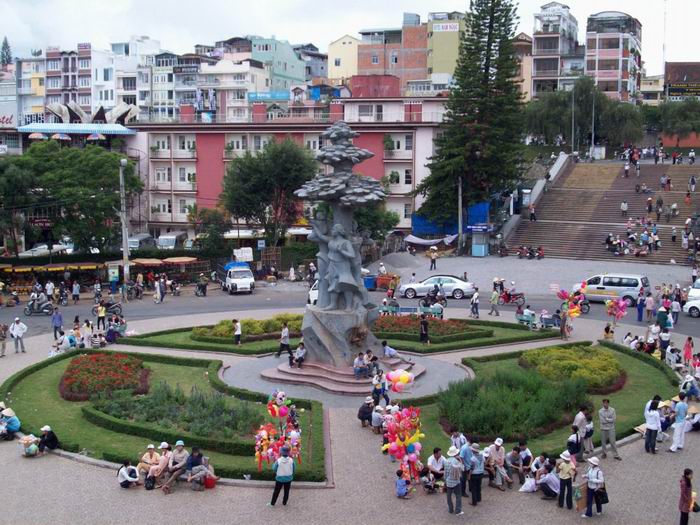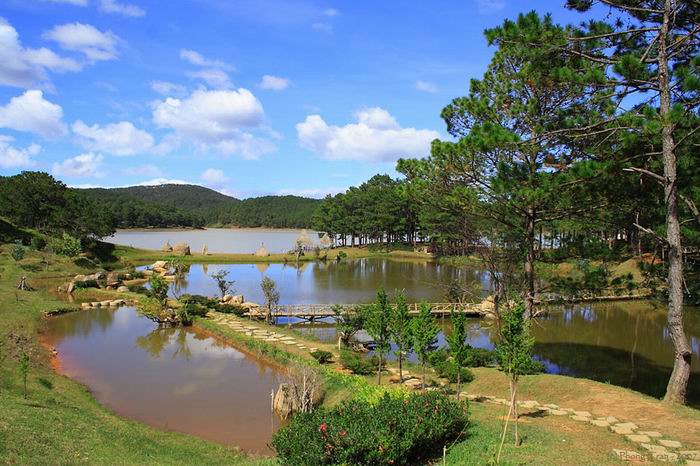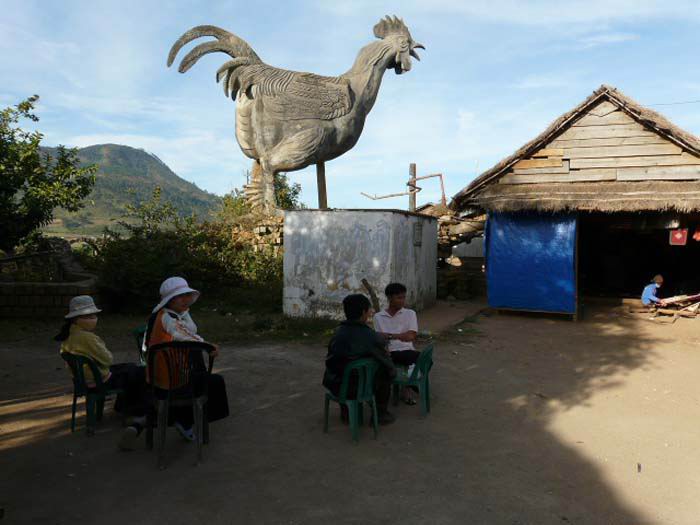Dalat
is quite different from anywhere else you'll
visit in Vietnam. You would
almost be forgiven for thinking you'd stumbled into the French Alps in
springtime. This was certainly how the former colonists treated it -
escaping to their chalets to enjoy the cooler climate. The French feel
is compounded by a radio mast shaped like the Eiffel Tower and the local
bohemian artists' predilection for swanning around in berets. Dalat is
small enough to remain charming, and die surrounding countryside is
blessed with lakes, waterfalls, evergreen forests and gardens. Local
products include silk, garden vegetables and flowers (especially
beautiful hydrangeas), which are sold all over
southern Vietnam. But the
biggest contribution to the economy is tourism: more than 800,000 domestic tourists and another 80,000 foreigners visit here every year.
It's the country's favourite honeymoon spot and still retains the final
word in Vietnamese kitsch. The Dalat area was once famous for hunting
and a 1950s brochure boasted that "a two-hour drive from the town leads
to several game-rich areas abounding in deer, roe, peacocks, pheasants,
wild boar, black bear. wild caws, panthers, tigers, gaurs and
elephants'. So successful were the hunters that all of the big game is
now extinct. The closest you'll get to the formerly diverse fauna are
the taxidermied specimens about town. The city's population includes
about 5000 members of hill tribes, which make up 33 distinct communities
in Lam Dong province. Traditional dress can occasionally be spotted in
the market places. Hill-tribe women of this area carry their infants on
their backs in a long piece of cloth worn over one shoulder and tied in
the front. The City of Eternal Spring, Dalat's temperature hovers
between a pleasant 15??C (average daily minimum) to 24??C (average daily
maximum). Effectively Dalat has two seasons - dry (December to March)
and wet (April to November). Despite the mild temperatures, by the end
of the dry season the lush green surrounds turn to brown. Even in the
wet season, mornings normally remain dry - allowing time for sightseeing
before the deluge begins.

This area has been home to
various Montagnard (hill tribe) groups for
centuries. In the local Lat language, 'Da Lat’ means 'River of the Lat
Tribe'. The first European to 'discover' Dalat was Dr Alexandre Yersin
in 1893. The city was established in 1912 and quickly became fashionable
with Europeans. At one point during the French colonial period, some 20%
of Dalat's population was foreign, as evidenced by the 2500-odd
chateau-style villas scattered around the city. During the American War,
Dalat was spared by the tacit agreement of all parties concerned.
Indeed, it seems that while South Vietnamese soldiers were being trained
at the city's military academy and affluent officials of the Saigon
regime were relaxing in their villas, Viet Cong cadres were doing the
same thing not far away in their villas. Dalat fell to North Vietnamese
forces without a fight on 3 April 1975. There is no problem with
leftover mines and ordnance in the area.
Dalat's sights are spread out and the terrain in and around the city is
hilly. Still, trekking or cycling is made easier by the cool
temperatures, The Central Market, set in a hollow, marks the middle of
the town. To the south-east the 'Eiffel Tower' of the main post office
is a useful landmark, rising above the southern shore of Xuan Huong
Lake.
Sights
XUAN HUONG LAKE
Created by a dam in 1919, banana-shaped Xuan Huong Lake was named after
a 17th-century Vietnamese poet known for her daring attacks on the
hypocrisy of social conventions and the foibles of scholars, monks,
mandarins and kings. The lake can be circumnavigated along a 7km sealed
path that leads past several of Dalat's main sights, including the
flower gardens, golf club and the majestic hilltop Hotel Sofitel Dalat
Palace.
HANG NGA CRAZY HOUSE
A perfect combination of Dalat's bohemian tradition and its taste for
kitsch. Hang Nga Crazy House is a guesthouse in the form of a
giant surreal artwork. The architecture is Gaudi-meets-Alice in
Wonderland and cannot easily be described: there are caves, giant spider
webs made of wire, concrete tree trunks and scary-looking animals with
glowing red eyes. Yes it's tacky, and exceedingly commercialised, but
many are astounded to find such a countercultural construction in
Vietnam. The owner of Hang Nga Crazy House, Mrs Dang Viet Nga, gained a
PhD in architecture in Moscow, where she lived for 14 years. Hang Nga,
as she's known locally, has designed a number of other buildings that
dot the landscape around Dalat, including the Children's Cultural Palace
and the Catholic church in Lien Khuong. The Dalat People’s Committee has
not always appreciated such innovative designs. An earlier Dalat
architectural masterpiece, the 'House with 100 Roofs', was torn down as
a fire hazard because the People's Commit-tee thought it looked
antisocialist. However, there is little chance that Hang Nga will have
such trouble with the authorities. Her father Truong Chinh, was Ho Chi
Minh's successor, serving as Vietnam's second president from 1981 until
his death in 1988. There's a fascinating display on his history and
achievements in the main hall. Probably the strangest thing about this
construction is that people can actually stay here (rooms range from
US$19 to US$84), although the constant stream of tourists and the
glowing red eyes of the giant kangaroo would surely take some getting
used to.
CREMAILLERE RAILWAY STATION
Dalat's pretty station is now largely
decorative. Railway enthusiasts will be interested in the old
locomotives on display, including a Japanese steam train. From 1928 to
1964, when it was closed because of VC attacks, the cog-railway linked Dalat and Thap Cham. It's unfortunate that the line has never been fully
replaced, as it would provide a great tourist link to the main
north-south lines. A section of track has been re-opened, allowing you
to ride in an historic carriage 8km to Trai Mat village (30 minutes) and
back again. Although there are scheduled six trains per day, in reality
this varies according to demand - they won't leave unless there's a
minimum of two passengers. Once in Trai Mat, most travellers make a
requisite stroll over to visit the ornate linh Phuoc Pagoda. This
colourful pagoda was built between 1949 and 1952, and recent renovations
included the installation of an 81/2-tonne bell in a seven-tiered tower.
Remove your shoes when entering the main temple building, where an
amusement-park dragon guards the gate. Once inside, visitors are greeted
by a 5m-high Buddha sporting a five-ringed neon halo. From the ground
floor, take the left-hand .staircase up to the 2nd-level balcony area
for great views.
BAO DAI'S SUMMER PALACE
This Art Deco-influenced villa was constructed in 1933 and was one of three
palaces Bao Dai kept in Dalat. The decor has not changed in decades,
except for the addition of Ho Chi Minh's portrait over the fireplace,
but the palace is filled with artefacts from decades and governments
past and is extremely interesting. In Bao Dai's office, the life-sized
white bust above the bookcase is of the man himself; the smaller gold and
brown busts are of his father. Emperor Khai Dinh. Note the heavy brass
royal seal (on the right) and military seal (on the left). The
photographs over the fireplace are of Bao Dai, his eldest son Bao Long
(in uniform), and his wife Empress Nam Phuong. Upstairs are the living
quarters. The room of Bao Long, who now lives in France, is decorated in
yellow, the royal colour. The huge semicircular couch was used by the
emperor and empress for family meetings, during which their three
daughters were seated in the yellow chairs and their two sons in the
pink chairs. Check out the ancient tan Rouathermique infrared sauna
machine near the top of the stairs. Bao Dai's Summer Palace is set in a
pine grove, 2km southwest of the city centre. Shoes must be removed at
the door. There's an extra charge for cameras and videos.
DALAT FLOWER GARDENS
An unusual sight in Vietnam, these gardens were established in 1966. Flowers here include hydran geas, fuchsias and orchids.
Most of the latter are in special shaded buildings to the right of the
entrance. All in all it's a very nice and well-kept cross section of
Dalat foliage, along with some crazy kitsch topiary. The Dalat Flower
Gardens front Xuan Huong Lake, on the road that leads from the lake to
Dalat University.
DOMAINE DE MARIE CONVENT
The pink tile-roofed structures of this hill-top convent, constructed
between 1940 and 1942, were once home to 300 nuns. Today the remaining
nuns support themselves by making ginger candies and selling the fruit
grown in the orchard out the back. The French-speaking nuns are pleased
to show visitors around and explain the work they do for orphans, the
homeless and children with disabilities. The shop sells handicrafts made
by the children and nuns. Mass is celebrated in the targe chapel, Sunday
to Friday.
LINH SON PAGODA
Built in 1938, this pagoda (Chua Linh Son; 120 Đ Nguyen Van Troi) is a
lovely ochre-coloured building that fuses French and Chinese
architecture. The giant bell is said to be made of bronze mixed with
gold, its great weight making it too heavy for thieves to carry off.
DALAT CATHEDRAL
This gingerbread-style cathedral ( Đ Tran Phu) was built between 1931
and 1942 for use by French residents and holiday-makers. The cross on
the spire is topped by a weathercock, 47m above the ground. The church
itself is rarely open outside of mass times.
DELECTABLE DALAT
For French colonists craving a taste of home, Dalat's climate was
perfectly suited for growing fresh garden vegetables. Peas, carrots,
radishes, tomatoes, cucumbers, avocados, capsicums, lettuce, beets,
green beans, potatoes, garlic, spinach, squash and yams are all grown
here, making for meals unavailable elsewhere in the country. The Dalat
area is justly famous for its strawberry jam, dried blackcurrants and
candied plums, persimmons and peaches. Apricots are popular, and often
served in a heavily salted hot drink. Other local delicacies include
avocado ice cream, sweet beans (mut dao) and strawberry, blackberry and
artichoke extracts (for making drinks). The strawberry extract is great
in tea. Artichoke tea, another local speciality, is said to lower blood
pressure and benefit the liver and kidneys. Dalat wine is served all
over Vietnam and some of it's quite good. Don't go stressing over grape
varietals - your choice is white or red. The reds are pleasantly light
in style, while the whites tend to be heavy on the oak. Dau hu, a type
of pudding made from soy milk, sugar and a slice of ginger, is one of
Dalat's specialities, as is hot soy milk (sua dau nanh). Both are sold
by itinerant female vendors, who walk around carrying a large bowl of
the stuff and a small stand suspended from either end of a bamboo pole.
Most vendors in the Central Market will let you sample a bit of
something before you buy.
AROUND DALAT
Valley of Love

Named the Valley of Peace by Emperor Bao Dai in a wonderful lack of
prescience, this valley had its name changed in 1972 by romantically minded students
from Dalat University. Today this ever-tacky place has taken on a
surreal atmosphere and cynical locals call it the Valley of Shops.
Tourist buses line up to regurgitate visitors and boats line up to
accommodate them. Get into the spirit with some aquatic activities:
paddle boats, 15-person canons and obnoxious noise-making motorboats can
be hired to tour the lake. This is a good place to sec the 'Dalat
cowboys': Vietnamese guides dressed as American cowboys. We've also seen
locals dressed as bears. The cowboys rent horses to tourists for a
guided tour around the lake. The cowboys and bears expect cash if you
take their picture. Refreshments and local delicacies (such as jams and
candied fruits) are on sale at the lookout near where the buses disgorge
tourists. The Valley of Love is 5km north of Xuan Huong Lake.
Lake of Sighs
The Lake of Sighs (Ho Than Tho; admission
5000d) is a natural lake enlarged by a French-built dam. The forests are
not Dalat's finest. The cheery name comes from the story of Mai Nuong
and Hoang Tung, who met here in 1788 while he was hunting and she was
picking mushrooms. They fell in love and sought their parents'
permission to marry. At that time Vietnam was threatened by a Chinese
invasion and Hoang Tung, like a macho fool, joined the army without
telling Mai Nuong. Mai Nuong sent word for him to meet her at the lake,
and when he didn't come she was overcome with sorrow and drowned
herself. She clearly wasn't used to being stood up. There are several
small restaurants up the hill from the dam- Horses can be hired for
80,000d an hour, while a ride in a horse-drawn carriage costs 140.000d
per hour. The Lake of Sighs is 6km northeast of the centre of Dalat via
Đ Phan Chu Trinh.
Quang Trung Reservoir
Quang Trung Reservoir (Tuyen Lam Lake) is an artificial lake created by
a dam in 1980. Paddle boats, rowboats and canoes can be hired nearby.
The hills around the reservoir are covered with pine trees, and there s
a path up the hill southwest of the water-intake tower. Ethnic-minority
farmers live and raise crops in the vicinity.
The fun way to get here is by cable car. If heights aren't your thing,
head out of Dalat on Hwy 20 and turn right at the signpost 5km from town
and continue for 2km.
Lat Village
The nine hamlets of Lat village (pronounced 'lak') are 12km
north of Dalat at the base of Lang Bian Mountain. Only five of the
hamlets are actually Lat; the residents of the other four are members of
the Chill, Ma and Koho tribes, each of which speaks a different dialect.
Traditionally, Lat houses are built on piles with rough plank walls and
a thatched roof. The people here eke out a living on 300 hec-tares of
land, growing rice, coffee, black beans and sweet potatoes. Economics
have forced many villagers into producing charcoal, a lowly task often
performed by Montagnards. Before 1975 many men from Lat worked with the
Americans, as did many Montagnards elsewhere. Classes in the village's
schools are conducted in Vietnamese rather than tribal languages. Lat
has one Catholic and one Protestant church. A Koho-language Bible (Sra
Goh) was published by Protestants in 1971; a Lat-Ianguage Bible,
prepared by Catholics, appeared a year later. Both dialects are quite
similar and are written in a Latin-based script. To get to Lat from
Dalat, head north on Đ Xo Viet Nghe Tinh. At Trung Lam Hamlet there's a
fork in the road marked by a street sign. Continue straight on
(northwest) rather than to the left. By bicycle the 12km trip from Dalat
to Lat takes about 40 minutes. On foot it's a two-hour walk.
Lang Bian Mountain
Also called Lam Vien Mountain, it has five volcanic peaks ranging in
altitude from 2100m to 2400m. Of the two highest peaks, the eastern one
is known by the woman's name K'Lang while the western one bears a i
man's name, K'Biang. Only the upper reaches of the mountain remain
forested. Only half a I century ago the foothills had lush foliage thai
sheltered wild oxen, deer, boars, elephants, rhinoceroses and tigers.
The hike up to the top's spectacular views takes three to four hours
from Lat village. The path begins due north of Lat and is recognisa-ble
as a red gash in the green mountainside.
Lang Dinh An (Chicken Village)

Famous for its giant concrete chicken caught mid-strut in the village
centre. Lang Dinh An has become very popular with travellers because
it's conveniently situated on the highway, 17km from Dalat. The village
is home to about 600 people of the Koho minority, who were enticed down
from the hills and have, to a certain extent, been Vietnamised. Most no
longer live in stilt houses and they wear Vietnamese-style clothing. The
chicken was an elaborate decorative device for a long-dysfunctional
water system, which used to crow as the water was pumped. The symbolism
of the chicken probably relates to yet another local legend involving i
doomed romance ending in a dead heroine. Though the residents of Chicken
village are extremely poor. we'd suggest that you don't give sweets or
money to the children. If you want to help the villagers, there are a
couple of shops where you can buy simple things like drinks and
biscuits. There are also beautiful weavings for sale near the highway.
Waterfalls
DATANLA FALLS
The nice thing about Datanla Falls is the short but
pleasant walk to get there. The cascade is 350m from Hwy 20 on a path that first passes through a pine forest and then continues steeply down
into a rainforest. The other good thing is the wildlife - lots of
squirrels, birds and butterflies. To get to Datanla Falls, turn right
off Hwy 20 about 200m past the turn- off to Quang Trung Reservoir. It's
well signposted.
Source: lonely planet